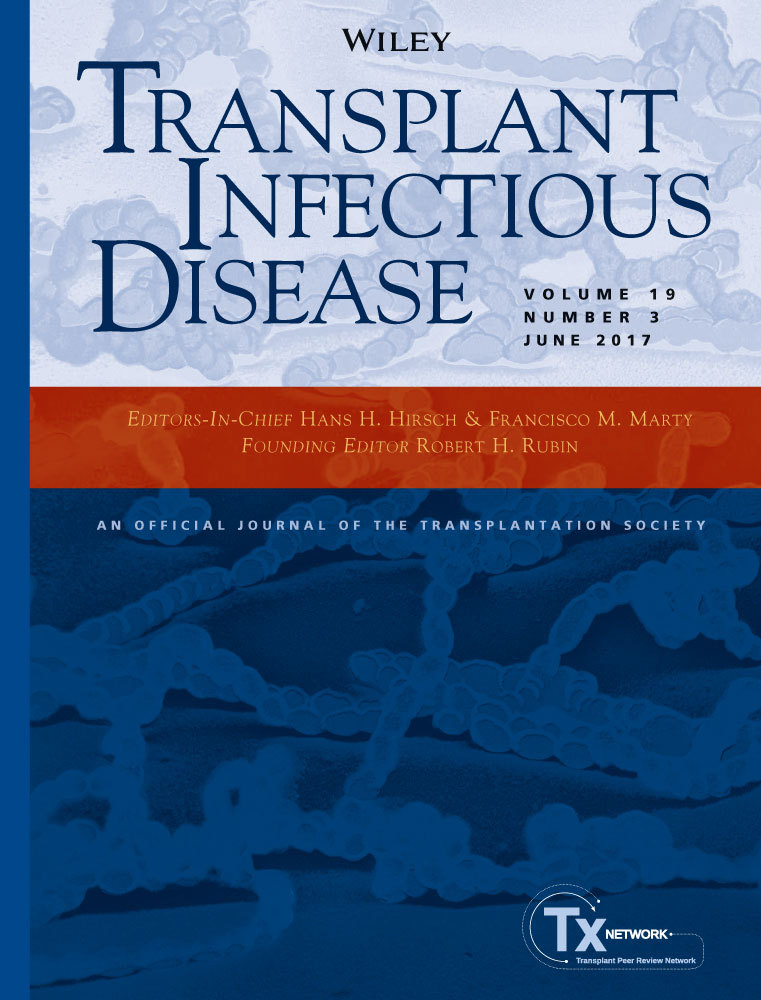Acute hepatitis E virus infection causing acute liver failure requiring living-donor liver transplantation in a non-pregnant immunocompetent woman
Corresponding Author
Iris Wai Sum Li
Queen Mary Hospital, Hong Kong, China
School of Public Health, The University of Hong Kong, Hong Kong, China
Correspondence
Iris Wai Sum Li, Queen Mary Hospital, Hong Kong, China.
Email: [email protected]
Search for more papers by this authorKenneth Siu Ho Chok
Department of Surgery, The University of Hong Kong, Hong Kong, China
Search for more papers by this authorCorresponding Author
Iris Wai Sum Li
Queen Mary Hospital, Hong Kong, China
School of Public Health, The University of Hong Kong, Hong Kong, China
Correspondence
Iris Wai Sum Li, Queen Mary Hospital, Hong Kong, China.
Email: [email protected]
Search for more papers by this authorKenneth Siu Ho Chok
Department of Surgery, The University of Hong Kong, Hong Kong, China
Search for more papers by this authorAbstract
We report a rare case of acute liver failure from acute hepatitis E virus (HEV) in a non-pregnant woman without comorbidities who survived after liver transplantation. The source was likely consumption of partially cooked pig liver. HEV genotype 3 is the second most common genotype causing acute hepatitis E in developed countries. Fulminant hepatitis E rarely occurs without a risk factor, as in our patient. Vigilant monitoring for chronic hepatitis E in post-transplant immunocompromised patients is needed.
REFERENCES
- 1Ahmad I, Holla RP, Jameel S. Molecular virology of hepatitis E virus. Virus Res. 2011; 161: 47-58.
- 2Mori Y, Matsuura Y. Structure of hepatitis E viral particle. Virus Res. 2011; 161: 59-64.
- 3Purdy MA, Khudyakov YE. The molecular epidemiology of hepatitis E virus infection. Virus Res. 2011; 161: 31-39.
- 4Aggarwal R. Clinical presentation of hepatitis E. Virus Res. 2011; 161: 15-22.
- 5Khuroo MS. Discovery of hepatitis E: The epidemic non-A, non-B hepatitis 30 years down the memory lane. Virus Res. 2011; 161: 3-14.
- 6Kamar N, Dalton HR, Abravanel F, Izopet J. Hepatitis E virus infection. Clin Microbiol Rev. 2014; 27: 116-138.
- 7Miyamura T. Hepatitis E virus infection in developed countries. Virus Res. 2011; 161: 40-46.
- 8Tai ALS, Cheng PKC, Ip SM, Wong RMC, Lim WWL. Molecular epidemiology of hepatitis E virus in Hong Kong. J Med Virol. 2009; 81: 1062-1068.
- 9Krain LJ, Nelson KE, Labrique AB. Host immune status and response to hepatitis E virus infection. Clin Microbiol Rev. 2014; 27: 139-165.
- 10Poudel S, Prajapati S, Prajapati BL, et al. Utility of total lymphocyte count as an affordable surrogate for CD4 lymphocyte count in HIV infected Nepali patients. J AIDS Clin Res. 2014; 5: 290.
- 11Sreenivasan S, Dasegowda V. Comparing absolute lymphocyte count to total lymphocyte count, as a CD4 T cell surrogate, to initiate antiretroviral therapy. J Glob Infect Dis. 2011; 3: 265-268.
- 12Shapiro NI, Karras DJ, Leech SH, Heilpern KL. Absolute lymphocyte count as a predictor of CD4 count. Ann Emerg Med. 1998; 32(3 Pt 1): 323-328.
- 13Woolson KL, Forbes A, Vine L, et al. Extra-hepatic manifestations of autochthonous hepatitis E infection. Aliment Pharmacol Ther. 2014; 40: 1282-1291.
- 14Drebber U, Odenthal M, Aberle SW, et al. Hepatitis E in liver biopsies from patients with acute hepatitis of clinically unexplained origin. Front Physiol. 2013; 4: 351.
- 15Inoue J, Nishizawa T, Takahashi M, et al. Analysis of the full-length genome of genotype 4 hepatitis E virus isolates from patients with fulminant or acute self-limited hepatitis E. J Med Virol. 2006; 78: 476-484.
- 16Inoue J, Takahashi M, Mizuo H, Suzuki K, Aikawa T, Shimosegawa T, Okamoto H. Nucleotide substitutions of hepatitis E virus genomes associated with fulminant hepatitis and disease severity. Tohoku J Exp Med. 2009; 218: 279-284.
- 17Lindahl TL, Egberg N, Hillarp A, et al. INR calibration of Owren-type prothrombin time based on the relationship between PT% and INR utilizing normal plasma samples. Thromb Haemost. 2004; 91: 1223-1231.
- 18Borkakoti J, Ahmed G, Kar P. Report of a novel C1483W mutation in the hepatitis E virus polymerase in patients with acute liver failure. Infect Genet Evol. 2016; 44: 51-54.
- 19Abravanel F, Mansuy JM, Huynh A, et al. Low risk of hepatitis E virus reactivation after haematopoietic stem cell transplantation. J Clin Virol. 2012; 54: 152-155.
- 20Kamar N, Garrouste C, Haagsma EB, et al. Factors associated with chronic hepatitis in patients with hepatitis E virus infection who have received solid organ transplants. Gastroenterology. 2011; 140: 1481-1489.
- 21Debing Y, Moradpour D, Neyts J, Gouttenoire J. Update on hepatitis E virology: Implications for clinical practice. J Hepatol. 2016; 65: 200-212.
- 22Zhao J, Wang S, Zhang T, et al. Pathological and virological studies of the liver tissues from the patients with sporadic hepatitis E. Zhonghua Shi Yan He Lin Chuang Bing Du Xue Za Zhi. 2001; 15: 205-207.
- 23Kamar N, Rostaing L, Abravanel F, et al. Pegylated interferon-alpha for treating chronic hepatitis E virus infection after liver transplantation. Clin Infect Dis. 2010; 50: e30-e33.
- 24Gerolami R, Borentain P, Raissouni F, Motte A, Solas C, Colson P. Treatment of severe acute hepatitis E by ribavirin. J Clin Virol. 2011; 52: 60-62.
- 25Chaillon A, Sirinelli A, De Muret A, Nicand E, d'Alteroche L, Goudeau A. Sustained virologic response with ribavirin in chronic hepatitis E virus infection in heart transplantation. J Heart Lung Transplant. 2011; 30: 841-843.
- 26Kamar N, Rostaing L, Abravanel F, et al. Ribavirin therapy inhibits viral replication on patients with chronic hepatitis E virus infection. Gastroenterology. 2010; 139: 1612-1628.
- 27Kamar N, Izopet J, Tripon S, et al. Ribavirin for chronic hepatitis E virus infection in transplant recipients. N Engl J Med. 2014; 370: 1111-1120.
- 28Dao Thi VL, Debing Y, Wu X, et al. Sofosbuvir inhibits hepatitis E virus replication in vitro and results in an additive effect when combined with ribavirin. Gastroenterology. 2016; 150: 82-85. e4.




